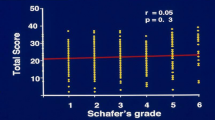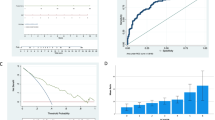Summary
Assessment of symptoms plays a central role in the evaluation of men with suspected bladder-outflow obstruction (BOO) secondary to benign prostatic hyperplasia (BPH). It is on the basis of symptoms that treatment designed to relieve outflow obstruction is recommended. However, a variety of studies have suggested that a considerable proportion of men presenting with suspected outflow obstruction are not obstructed as determined by pressure-flow criteria. The relationship between many so-called “obstructive” symptoms and BOO has not yet been defined. Furthermore, all previous studies have defined BOO on the basis of urethral resistance factors, which are now regarded as outdated. Using current concepts of urethral pressure-flow relationships, we studied in detail the relationship between the “obstructive” symptoms of BPH, objective evidence of abormal voiding and BOO. Only the symptoms of hesitancy and poor flow were found to be significantly related to BOO. The symptoms of straining to void, intermittency, terminal dribbling and feeling of incomplete bladder emptying were not specific for BOO. Objective evidence of an intermittent flow pattern and of terminal dribbling do, however, have a high specificity and positive predictive value for BOO. The assessment of men with lower-urinary-tract symptoms must include objective tests of voiding function. A better understanding of the pathophysiology of lower-urinary-tract symptoms should lead to an improved symptomatic outcome of prostatectomy.
Similar content being viewed by others
References
Abrams P (1993) The objective evaluation of bladder outflow obstruction. In: Cockett ATK, Khoury S, Aso Y, Chatelain C, Denis L, Griffiths K, Murphy G (eds) Proceedings of the 2nd international consultation on benign prostatic hyperplasia (BPH). Scientific Communication International Ltd. Jersey, pp 151–226
Abrams P, Griffiths DJ (1979) The assessment of prostatic obstruction from urodynamic measurements and from residual urine. Br J Urol 51:129–134
Abrams P, Farrar DJ, Turner-Warwick RT, Whiteside CG, Feneley RCL (1979) The results of prostatectomy: a symptomatic and urodynamic analysis of 152 patients. J Urol 121:640–642
Abrams P, Blaivas JG, Stanton SL, Andersen JT (1988) Standardisation of terminology of the lower urinary tract. Neurourol Urodyn 7:403–427
Barry MJ, Fowler FJ Jr, O'Leary MP, Bruskewitz RC, Holtgrewe HL, Mebust WK, Cockett ATK, the Measurement Committee of the American Urological Association (1992) The American Urological Association symptom index for benign prostatic hyperplasia. J Urol 148:1549–1557
Bruskewitz R, Larsen EH, Madsen PO, Dorflinger T (1986) 3-Year follow-up of urinary symptoms after transurethral resection of the prostate. J Urol 136:613–615
Chai TC, Belville WD, McGuire EJ, Nyquist L (1993) Specificity of the American Urological Association symptom index: comparison of unselected and selected samples of both sexes. J Urol 150:1710–1713
Chancellor MB, Rivas DA (1993) American Urological Association symptom index for women with voiding symptoms: lack of specificity for benign prostatic hyperplasia. J Urol 150:1706–1709
Chancellor MB, Rivas DA, Keeley FX, Lofti MA, Gomella LG (1994) Similarity of the American Urological Association symptom index among men with benign prostatic hyperplasia (BPH), urethral obstruction not due to BPH and detrusor instability without blader outlet obstruction. Br J Urol 74:200–203
Doll HA, Black NA, McPherson K, Flood AB, Williams GB, Smith JC (1992) Mortality, morbidity and complications following transurethral resection of the prostate for benign prostatic hypertrophy. J Urol 147:1566–1573
Fowler FJ, Wennberg JE, Timothy RP, Barry MJ, Mulley AG, Hanley D (1988) Symptom status and quality of life after prostatectomy. JAMA 259:3018–3022
Hald T, Nordling J, Andersen JT, Bilde T, Meyhoff HH, Walter S (1991) A patient weighted symptom score in the evaluation of uncomplicated benign prostatic hyperplasia. Scand J Urol Nephrol 138:59–62
Jensen KM-E (1989) Clinical evaluation of routine urodynamic investigations in prostatism. Neurourol Urodyn 8:545–578
McLoughlin J, Gill KP, Abel PB, Williams G (1990) Symptoms versus flow rates versus urodynamics in the selection of patients for prostatectomy. Br J Urol 60:303–305
Mebust WK (1988) Surgical management of benign prostatic obstruction. Urology 32 [Suppl]:12–15
Mebust WK, Holtgrewe HL, Cockett ATK, Peters PC (1989) Transurethral prostatectomy: immediate and postoperative complications. A co-operative study of 13 participating institutions evaluating 3885 patients. J Urol 141:243
Neal DE, Ramsden PD, Sharples L, Smith A, Powell PH, Styles RA, Webb RJ (1989) Outcome of elective prostatectomy. BMJ 299:762–767
Nielsen KT, Christiansen MM, Madsen PO, Bruskewitz RC (1989) Symptom analysis and uroflowmetry 7 years after transurethral resection of the prostate. J Urol 142:1251–1253
Rollema HJ, Mastrigt R van (1992) Improved indication and follow-up in transurethral resection of the prostate using the computer program CLIM: a prospective study. J Urol 148:111–116
Roos NP, Wennberg J, Malenka DJ, Fisher ES, McPherson K, Andersen TF, Cohen MM, Ramsay E (1989) Mortality and reoperation after open and transurethral resection of the prostate for benign prostatic hyperplasia. N Engl J Med 320:1120–1124
Schäfer W, Rubben H, Noppeney R, Deutz FJ (1989) Obstructed and unobstructed prostatic obstruction. A plea for urodynamic objectivation of bladder outflow obstruction in benign prostatic hyperplasia. World J Urol 6:198–203
Spangberg A, Terio H, Engberg A, Ask P (1989) Quantification of urethral function based on Griffiths' model of flow through elastic tubes. Neurourol Urodyn 8:29–52
Wasson J (1993) A comparison of quality of life with patient reported symptoms and objective findings in men with benign prostatic hyperplasia. J Urol 150:1696–1700
Author information
Authors and Affiliations
Rights and permissions
About this article
Cite this article
Reynard, J.M., Abrams, P. Bladder-outlet obstruction — assessment of symptoms. World J Urol 13, 3–8 (1995). https://doi.org/10.1007/BF00182657
Issue Date:
DOI: https://doi.org/10.1007/BF00182657




